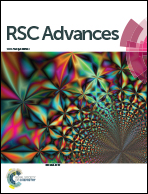Enhanced thermoelectric performance in a metal/semiconductor nanocomposite of iron silicide/silicon germanium
Abstract
Hypothetical efficient thermoelectrics based on nanoparticles in alloys of silicide nanocomposites were predicted by Mingo et al. This investigation presents the experimental realization of an n-type silicon germanium alloy with an embedded metallic α-phase iron silicide (FeSi2). The dimensionless thermoelectric figure of merit (ZT) of the nanocomposite material was higher than the peak ZT of the conventional single phase Si0.80Ge0.20 over a broad temperature range (650–1000 °C) while consuming smaller amounts of germanium. The addition of 2.5% silver to the nanocomposite, which acted as a sintering aid, reduced the sintering temperature and resulted in smaller thermal conductivity. The optimum material composition of (Si0.88Ge0.12)0.925–(FeSi2)0.05–Ag0.025 was found after investigation of a large number of nanocomposite materials. The combination of X-ray diffraction, energy-dispersive X-ray spectroscopy, and transmission electron microscopy analysis confirmed a uniform distribution of α-FeSi2 nanoparticles in the microstructure.



 Please wait while we load your content...
Please wait while we load your content...